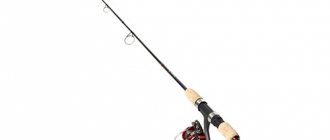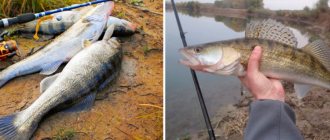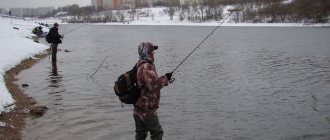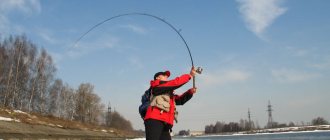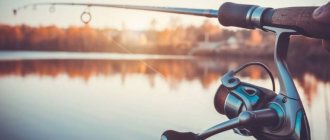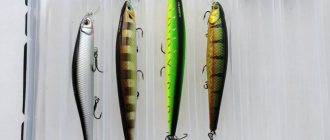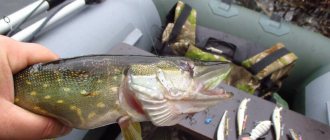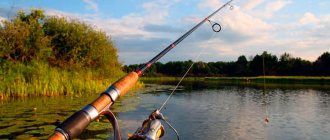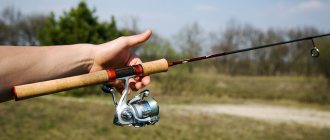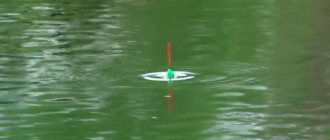A large predatory fish is a very dexterous and cunning opponent. It is not worth trying to fight in a fight without preparation with the hope of success. There is a much greater likelihood of the gear breaking and the bait being lost. And learning how to use a spinning rod professionally will not happen in just one fishing trip. Masters spend years mastering this craft, never ceasing to learn something new.
Therefore, in order for beginners to understand the operation of a fishing rod, the nuances of fish behavior must begin with theoretical foundations and gradually move on to practice. This article will help you quickly understand the main principles of active fishing, the secrets of choosing a suitable spinning rod and equipment for it. Will point out the best biting spots, features of different types of baits.
How to choose the right fishing rod
We recommend taking into account several important points:
- Fishing conditions. Fishing will take place from the shore or from a boat.
- When fishing from a boat near a coastline filled with vegetation, you need to take short tackle up to 2.1 m long. On clean beaches, from the bridge, a spinning rod up to 3.5 m long is preferable.
- To catch a predator, a plug rod is considered the most convenient.
- The optimal gear material is a carbon fiber composite. It is light and even during long fishing your hand will not get tired.
- The test and system are selected based on the type, weight of the bait used, and wiring options.
- It is believed that fast action rods effectively perform hooking, but do not absorb well the jerks of the fish when playing. Slow ones are less sensitive, but work great when fishing, softening sharp jerks.
- For beginners, to practice the accuracy of casting and wiring techniques, you can opt for medium tackle or another universal option. And by acquiring skills, gradually move on to more narrow-profile products.
What is a spinning test
Test – weight range of baits used. Indicates the maximum permissible bait weight limit.
Depending on the indicator, rods are divided into the following classes:
- Ultralight. UL marked. Lightweight spinning rod with a weight of up to 5 g. Suitable for catching small perch or even chub and roach. The casting distance does not exceed 20 m.
- Light. Marked L. This type of rod is used for fishing from the shore. The dough is up to 15 g. The average pike and perch take this bait. The casting distance does not exceed 35 m.
- Medium or average (medium). Marked M. Test up to 30 g. It is considered a universal rod because it is suitable for any predatory fish. You can fish both from the shore and from a boat.
- Heavy. Marked H. Used for large specimens of catfish, pike, asp, and bream. Test from 40 g and more.
Products are produced marked MH, ML - intermediate classes, which stand for medium-heavy, medium-light. If you come across other variants of unfamiliar markings, then look carefully at the grams. This will make it easier to navigate.
What is rod action?
Action is the amplitude of flexibility of the tackle under the influence of load. Displays the hardness of the blank. Affects the speed and accuracy of spinning control.
There are 4 types:
- Very fast. Only the tip of the rod is flexible. Allows you to cast with high precision. Provides high-quality hooking. It is distinguished by high sensitivity and durability. Disadvantages: short casting range, poor shock absorption when fishing, which can lead to the loss of the bait.
- Fast. Flexible ½ part of the tackle. Half formation.
- Average. Flexible ¾ part of the rod.
- Slow. The entire working part of the rod is flexible. Possibility of using thin lines in equipment. Long cast. Excellent cushioning when playing. But with this system, casting accuracy suffers, hooking occurs with a delay. Low sensitivity.
For beginners in fishing, a quick action will suffice. You can check the system for compliance with what is specified in the instructions even upon purchase. You need to lightly wave the rod. If the tip bends and immediately returns to its original position, then it is very fast. When the top bent forward, it returned back and took its starting point - a fast formation.
Fishing methods
- Spinning fishing from the shore involves constant movement of the angler. Good places can be oxbow lakes, backwaters, and tributaries of rivers. In the fall you need to look for, or already know, deep areas. There, production is being prepared for the winter period. The period from the end of September to the end of November is especially lucky. Fishing for pike during this period requires the presence of powerful gear; a leash is required;
- Fishing from a boat has great advantages compared to shore fishing. On large lakes, large individuals do not approach the shore. Using a boat allows you to search for trophies throughout the entire water area. And using an echo sounder, you can read the bottom topography and see the movement of prey.
The spinning rod for fishing from a boat should be shorter than for fishing on the shore. On a boat, the fisherman is limited in his movements and less stable. The length of the blank is no more than 2.5 m. A short spinning rod is the most convenient weapon for fishing from a boat. The main thing here is convenience and personal safety. Wait, preferably quickly, test up to 40 degrees.
Choosing a coil
The best option is to simultaneously purchase a reel and a spinning rod. In this case, it will be possible to select models that suit each other as accurately as possible. If this is not possible, then it is better to take the rod with you so that you can try attaching a reel to it on the spot and work with it.
What types of them exist?
According to design and operating principle, they are divided into 3 types:
- Inertial. They have lost their former popularity due to lack of technological improvement. But there are fishermen who today continue to catch worthwhile trophies using inertia.
- Inertialess. The most famous version of reels among amateurs and professional spinners. Simple and easy to use. Provides accurate long-distance casting.
- Multiplier. Designed for craftsmen. They have not yet received much demand due to the high cost. They are distinguished by high sensitivity, which allows you to feel even very careful bites.
For beginners, a spinning reel is suitable. It will be inexpensive and easy to deal with.
Spool: size and material
When choosing a reel, the quality of the spool is key.
It is important to pay attention to the following factors:
- Material type. Metal spools are considered the most durable.
- Forest capacity and capacity. When analyzing this value, the length of the rod is taken into account. Marked with thousandth indices such as 1000, 2000, 2500 and others. There is no uniform classification, so depending on the brand, the labeling may differ. For an average spinning rod with a length of 2 m, a 2000 reel is suitable (will fit 100 m of fishing line with a thickness of 0.2 mm or 200 m of fishing line with a thickness of 0.1 mm). If the length of the blank is 2.5 m, then a 2500 reel is enough. For coastal fishing - 3000.
- Spare spool. It's not required, but it wouldn't be superfluous. For example, a fisherman will be able to experiment with fishing with braid, then change to a spool with monofilament line.
- Pay attention to the prices of the reels. The kit with a spare spool often increases the price tag by 25–30%.
Number of bearings
Affects the quality of work, the speed of the reel mechanism and its wear. In expensive models, the number of bearings is much greater than in budget products. But if you don’t have enough finances to buy a good imported version of the coil, then pay attention to their location.
Bearings must be installed:
- on the rotor;
- on both sides on the reel handle shaft;
- line roller.
On these parts, fastening bearings is mandatory, since with constant operation of the reel, these places wear out most quickly. As for the reel speed, the choice here is individual. Power or speed are considered optimal. Depending on the manufacturer, the gear ratio is indicated differently. There are markings 4:1, 4.6:1 or 5:1, 5.2:1.
Friction and its meaning
A correctly configured friction brake will prevent catch loss and preserve the integrity of the equipment and fishing rod. By design it happens:
- rear;
- front.
The rear clutch setup is more complex. The reel becomes heavy and bulky. Has a long service life. The front friction brake allows for fine tuning. They are easier to manage. But less reliable. A suitable option for beginners.
It's impossible to say which one is better. It all depends on the preferences of the fisherman himself. The main thing is to pay attention to the quality of fasteners and materials. Any factory markings must not be erased. There are no scratches or defects on the surface.
Coil selection
Today, all spinning anglers equip their rods with spinning reels. For a beginning spinning player, a spinning reel of size 2000-3000 is suitable. These numbers mean that 100 m of fishing line with a diameter of 0.2-0.3 mm can be wound on such a reel. As practice shows, this amount of fishing line is quite enough for spinning fishing, both from the shore and from a boat.
When choosing a reel, you should pay attention to the presence of a friction brake, either front or rear. Many reels, size 2000, do not have such a brake, and why would a reel that is designed for catching small fish need a brake? Therefore, the spinning angler’s task is to choose a reliable reel with all the functionality, even if he is a novice spinning angler.
They “drive” the fish and try to tire them out. It works well when the fish is at a distance and does not see the angler. On the contrary, when fishing from a boat, the fish gets scared and can break the tackle and dive under the boat.
Diameters of fishing line and braided cord
Depending on the distance and other factors, spinning fishing is carried out using 2 types of fishing line:
- Monofilament. Stretches well. It features high shock absorption when playing fish. But it has low sensitivity when casting long distances. Therefore, monofilament fishing line is used to fish at short distances near the shore, near the boat. For a predator, the recommended thickness is 0.2 mm.
- Wicker. The structure of the thread is rigid. Doesn't stretch. Excellent transmission of bites during long casts. It is convenient to monitor the game of the bait. In terms of strength and breaking load, it is several times superior to monofilament fishing line. They fish with braided line from the shore in wide reservoirs. The optimal diameter is from 0.12 to 0.18 mm.
IMPORTANT! It is recommended to supplement the tackle with a leash when catching a predator such as pike.
Modern materials for leashes are created from Kevlar and fluorocarbon raw materials. It is allowed to use durable leashes made of steel, tungsten, titanium, but their disadvantage is the deterioration of the bait’s performance. The standard leash length is from 15 to 20 cm.
When hunting for another predator, leashes are rarely used. More often, the bait is immediately tied to a thread or a carabiner or clasp is used as an addition. You will need a swivel for rotating spoons - this is protection against twisting and premature deformation of the cord.
Equipment
First you need to determine what kind of fish you are going to use the gear for, and the conditions for future fishing. After purchasing the gear and necessary accessories, you need to assemble the spinning rod. This is done like this:
- A reel with fishing line is installed on the spinning rod. It should be located at a distance of 30 to 40 centimeters, counting from the first ring;
- Depending on the fishing conditions and whether long casting is required, choose the length of the fishing line;
- A leash is mounted at the end of the fishing line. If you are fishing for fish that swallow bait deeply or that have very sharp teeth or graters, like catfish, then you need to choose a long leash. Moreover, it must be metal;
- The fish bait is attached to the leash using a special carabiner.
The equipment is modified depending on the spinning fishing technique used.
What baits are used
A wide selection of baits made from artificial materials are available for sale at different prices. The best option is a product from a trusted manufacturer with strong fittings and good color coverage. Selection is carried out according to the type of fishing, rod, expected size of prey.
Artificial products are divided into 3 types:
- Wobblers. The main raw material is polymer. Appearance: imitation of a small fish. They have a unique game. High catchability. Depending on the set of properties, they have their own classification (shads, minnows, poppers, walkers and others). They require the fisherman to have knowledge of different fishing techniques. Beginners need to start with something simpler. Used for twitching and trolling.
- Spoons. In the classic version there are rotating and oscillating. They are purchased strictly for a specific type of fish. Modern modifications are produced - spinnerbaits, castmasters. Can even be used for winter fishing.
- Silicone. From this raw material, imitation worms and various insects (twisters, vibrohosts, slugs and others) are produced. Choice of colors. They are inexpensive. But the service life is limited. Edible silicone is considered more effective, since fish are attracted not only by appearance, game, but also by smell. An excellent start for practicing wiring for beginners.
But if a predator is reluctant to respond to artificial bait, then one should not forget about bait of animal origin - dung worms, maggots, grasshoppers.
Surface fishing with spinning rod
Surface lures add a pleasant touch to everyday fishing. Most often, surface activity is observed in the warm season in periods bordering on darkness, in the morning and evening. It is not necessary that a predator should give itself away in bursts.
Being in the water column, active fish are able to rise several meters. I have repeatedly observed such a picture on overgrown reservoirs in the morning, when there were much fewer bites on the classic bait for this place than on the surface bait. In such a situation, the Megabass Dog-X SL helped me a lot, which did an excellent job with its goal, thanks to its sweeping play and the sounds it made, it attracted pike from great distances.
Surface fishing is distinguished by its distinctness: either yes or no. If fishing with surface baits is justified under these conditions, then the result will not be long in coming. Depending on the conditions, you can use a variety of gear, so I will not consider the arsenal of gear in this section.
Jig fishing
It is considered the easiest way to catch predatory individuals. Does not require the purchase and assembly of expensive equipment. Among the features of jig fishing:
- Often this is shore fishing. This method is used to fish coastal dumps, places under snags, and coastal holes. With such equipment, you can also engage in bottom capture of predators.
- Fishing objects: pike, ide, perch, chub, asp, pike perch.
- The standard length of a jig spinning rod is from 2.5 to 3 m.
- Build – fast or very fast. So that the play of the bait and the bite can be clearly seen by the movement of the tip of the tackle.
- It has good flight properties, making it possible to get a tricky trophy even from great depths.
When assembling the rig, you need to carefully consider what type of braid to use. The weight of the sinker depends on the thickness, and the quality of the material determines the performance of the equipment. The versatility of the jig lies in the fact that you can catch perch and pike with large baits with a small sinker in shallow water and high vegetation.
There are several types of jig rigs:
- dropshot;
- Caroline;
- tokyo rig;
- Texas;
- jig-rig;
- diverter leash and others.
To increase the casting distance, it is recommended to take a rod with a fast, medium, or very fast action. With a jig rig, it will be possible to fish without problems in shallow water, overgrown banks, and reservoirs with strong currents.
Methods of spinning fishing and the choice of bait for a novice fisherman
Silicone baits are very popular in jig fishing.
The three most common spinning fishing techniques are:
- Jig - fishing with jig baits or rigs using a load, playing with bait is carried out exclusively in the bottom layer, most often with stepped retrieve;
- Twitching - fishing with wobblers and poppers, making jerking movements with the tip of the rod;
- Spinnering is fishing with rotating and oscillating spinners, as well as a number of other baits; there is most often no play with bait as such, just uniform retrieval is carried out.
Beginner's choice: jig and spinner
A jig will allow you to catch a predator in its usual habitat - on the bottom, while the jig fishing technique at the initial stage of familiarization will not cause any great difficulties and you will be able to fish at an acceptable level during your first fishing trips and even catch something.
Get acquainted with the technique of fishing with a retractable leash; this is one of the most popular jig rigs, very easy to make and effective for catching pike perch, perch, pike, bersh and even catfish.
The most popular baits used in line fishing and jig fishing are silicone baits:
- twisters;
- vibrotails.
In stores you can find flavored versions; fishermen call this silicone edible rubber. Fish attack scented bait more actively.
lures because a novice fisherman does not need any fishing skills at all. You simply tie a swivel to the end of your line and then attach the spinner. There are:
- spinners;
- fluctuating;
- cicadas (bladebaits);
- castmasters;
- spinnerbaits.
Read a detailed guide on spinning baits.
Fishing with wobblers from the shore
This is an affordable way to catch predatory fish in the absence of a swimming device. But there is a significant disadvantage, unlike fishing from a boat - when you catch on grass, algae, or snags, there is a high risk of the bait breaking. If you lose bait on a boat, there is a chance to swim up and get it, but there is no such opportunity from the shore.
When fishing on an unfamiliar body of water, in order to understand what kind of bottom you have to deal with, it is better to attach an inexpensive bait, which you will not regret if you lose it. When fishing with wobblers from the shore, jerk retrieves with minnow-type wobblers are in demand.
Among the main nuances of such fishing:
- Although the choice of spinning rod length is individual, the generally accepted parameters for twitching are considered to be a range from 1.8 to 2.2 m.
- A very fast action of the tackle is not suitable for jerking retrieves, since due to only a working tip, it is not possible to set the wobbler to the desired dynamics of movement. Therefore, preference is given to the Regular Fast tuning. So, while the wobbler is playing, the blank will work along its entire length and you can increase the casting distance.
- The spinning rod is taken hard so that the form does not fall through during the jerk.
- In this method, the predator is caught at any depth, type of reservoir.
- In fast currents, jerking is not as effective. Here it is better to use uniform or stop and go (with pauses).
Another popular variety of wobblers are shads and cranks. Among the nuances:
- Both types have their own unique gameplay, so the fisherman does not need to provide additional animation.
- The rod is not taken as rigid as for twitching.
- Build – Regular Fast.
- Cranks are used on riffles near the shore, in shallow water. Used on chub, ide, pike perch, asp, perch.
- Shad are caught in holes near the shore, places with sharp changes in depth. Perch and pike perch are responding.
There are surface wobblers on sale with a depth of no more than 20 cm:
- poppers;
- walkers;
- minnow.
With such a bait you will again need jerk wiring. Fishing places: shallow river beds, shallow lakes.
The first choice is subjective: what kind of fish can you Catch with spinning?
The first question that arises even when getting ready for fishing is - who, exactly, are we going to catch? The answer to this is largely related to our character and fishing habits. As they say, there is no arguing about tastes, so the following options are possible here:
Fishing for pleasure or for food?
In fact, the question is not posed entirely correctly, because the first does not at all exclude the second, and vice versa. However, for most spinning anglers, fishing is primarily relaxation and pleasure. Almost all fishermen from large cities who have to go fishing fall into this part - willingly or unwillingly. Indeed, now in 99% of such cases, the caught fish (if any) does not even justify the cost of gear and gasoline, not to mention boats, vouchers and overnight accommodations. But you can always have fun, because every rare fishing trip is a holiday!
It is clear that the measure of pleasure is primarily the number of bites and fish caught, and only then the weight of the catch. Therefore, many prefer to catch heels of perches better than one pike, even if it is twice as heavy. And to realize your passion for sports, you can use the lightest gear. Then a 100-gram “sailor” will bend the rod into an arc, and you will have to fish it out for several minutes. And it turns out that catching bleak on a spinning rod is no less exciting. Pike - anyone can catch it! And here you have to get smart! It’s no wonder that there are more and more fans of “ultralight”.
By the way, if there is no cat at home, then the “prey” is released back without regret.
If a spinner has a river close by and goes fishing at least every day, then the philosophy is different. I want not only to relax, but also to have some fish on the table! And here one pike already “outweighs” the heels of the perches in the minds of the heels - and there is something to brag about, and there is less work for the wife. Although there are a lot of romantics here too - they went out to the pond, threw a spoon, talked with the same fishermen... Is it normal, Grigory? Great, Konstantin!
Should you catch a specific fish or all of them?
It’s easiest for those fishermen who, for example, go only for pike. Moreover, no less than a kilogram. By the way, quite often you see spinners who have one spinner for all occasions - and it doesn’t seem to be retied until it breaks. It is from them that you usually hear phrases like: “They only bite here on yellow spoon bait!” Despite all their apparent simplicity, these fishermen are very mobile, they know exactly what they want and do not worry about choosing the optimal bait. Agree, this is better than carrying around a bunch of gear and not knowing what to grab onto.
The other extreme is to catch everything that can be caught. However, this requires a lot of different gear and bait, as well as enough time for constant re-equipment. And usually there is not enough time. And it’s very inconvenient to carry two rods and a box of bait with you when fishing from the shore. But on stationary fishing - next to a camp or car - it is quite possible to catch “everything”. For example, if small change starts to “beat”, running to the tent and taking an “ultralight” is not a problem. The same can be said about fishing from a boat, where 2-3 equipped spinning rods will always fit.
Between two extremes there is always a “golden mean”. Therefore, most often, some kind of compromise-universal option is used, which allows you to catch at least 3-4 of the most interesting species of fish with one tackle. And even if such gear is not ideal for a particular type of predator, it is optimal for interesting multifaceted fishing and is mobile.
By the way, for relative versatility, just an additional spool is enough. Wrap a thinner monofilament thread there and you can quickly switch from pike to perch. After all, even a relatively hard spinning rod will cast a small bait, but on a thin line. And by weakening the friction brake, we will protect the weak lips of the “striped” from breaking when hooking and retrieving. Another example is that an additional spool with thin “braid” will allow you to quickly switch from medium-weight heads to the lightest jigs for small (such as perch) or “unexpected” (such as ide and chub) predators.
Should I catch trophy fish or all of them?
A special group of spinning anglers are fans of trophy fishing. As a rule, they do not recognize prey smaller than a kilogram, and the “norm” is usually considered to be 2-3 kg, although they often catch “crocodiles” weighing 5-10 kg. However, such fishing requires not only special gear (and, as a rule, a boat), but also a special tactical approach. And most importantly - patience!
So, choose for yourself what suits you best.
Fishing with spinners (iron)
Spinner baits are considered the lures of the past. In reservoirs with a constant concentration of fishermen, the predator has become more capricious, and therefore responds to spinners less and less often. But on reservoirs remote from big cities, spoons never lose their popularity and catchability.
To choose the right lure for fishing, we recommend considering the following tips:
- Large spoons are often used for pike in any reservoir.
- Non-hooking baits are a universal bait for rivers with overgrown banks and lakes.
- A standard spinner is enough for perch and small pike.
- Asp are caught using jigs. A hook with an edge (wabik) is crocheted above the spinner. Suitable places for catching are rocky rifts, spits, near deep holes. If there are a lot of snags on the pond, then it is better to take jigs with a wide body so that it penetrates less into the water. The asp is a very careful predator, so you need to take the rod as long as possible.
- A narrow, driven spoon works well for long casting.
- Micro spinners and micro spinners are great for ultralight fishing. With these lures you can catch predators and peaceful fish. The type of reservoir does not matter. Build – Regular Fast. The hardness is average.
When choosing a spinner as bait, it is important to understand that this is not a stubborn product and the action of the rod must be soft. The average length of a spinning rod is up to 3 m.
What kind of fish are caught with a spinning rod?
Theoretically, you can catch any fish with a spinning rod. The most common predators fishermen encounter are: pike, perch, pike perch, bersh, asp, catfish, trout, salmon, and brown trout. Semi-predatory chub, ide and grayling are also often bitten, and you can also catch even relatively peaceful fish: sabrefish, rudd, roach, bream, bleak. If only we had this fish in our pond...
It is clear that each fish needs its own gear and bait, and there are fewer and fewer fish in reservoirs - so in reality, spinning anglers usually catch only 1-3 “close” species of fish: pike and perch, pike perch and bersh, ide and chub... And this is still good - but sometimes they don’t catch anything... It’s not for nothing that they say that going fishing and going fishing are not the same thing...
About microjig
A universal way to catch peaceful, predatory fish in any body of water. The rod and equipment are light. Minus - possible trophy options will be small in size, but this is compensated by their quantity.
Spinning rods with 2 types of tips are suitable for microjigging:
- Tubular. A hollow tip that comes complete with the blank. Convenient for fishing on the river and reservoir. This rod has good sensors. Wiring type – jerky. The disadvantage is the high cost.
- Solid. The top is made as a monolithic glued part. The material may contain fiberglass. The tip is very sensitive. It perfectly reflects even a weak bite when the bait collides with an obstacle or touches the bottom. The price is affordable.
The choice is made by the fisherman individually, based on financial capabilities and experience of past fishing trips.
Shore fishing tactics
Spinning fishing - both by boat and when fishing from the shore - involves, first of all, actively moving around a body of water and searching for a predator , and fishing from the shore is no exception: as a rule, the more a spinner travels along the shore during fishing, the larger his catch in the end he can boast. At the same time, of course, you need to move wisely, and there is no need for unnecessary haste here.
When moving around a body of water, of course, you should pay special attention to standard promising points - thickets of grass, snags, boulders lying on the bottom, holes, edges, bridge piles, and so on.
If when fishing on a lake you can move in any direction, then when fishing on a river, as a rule, you should go downstream .
Search for active fish in the coastal zone
With this fishing option, the spinner quickly moves along the shore, performing two series of casts at each new point: the first - almost to his feet, then the second - to a distance of 30 - 40 meters. There is no need to be clever with baits and retrieving techniques: this fishing tactic is aimed specifically at “collecting” active fish , which, as a rule, quickly respond to almost everything that a spinning angler can offer it.
Catching promising points
This tactical scheme is best suited for fishing on a well-known body of water , when the spinning angler is well aware of several interesting places in which the predator stands and hunts.
The fisherman carefully fishes the first point, which may give him one or several trophies or not bring a single bite, and then goes to the second, third, fourth promising area.
After a few hours, you can return to the first point and then go through all the others again.
Fishing at one point
This tactic is often chosen by novice fishermen. Knowing one or two excellent spots on a body of water, they spend all their time and effort fishing for them with all possible baits with different types of retrieves - in the fishing community this is called “running into a promising place.”
Despite the fact that this approach can also bring a decent result, you should still try to move more around the reservoir , discovering new interesting and catchy points.
What are the stages of the process?
When a decision has been made about the intended catch and the equipment has been assembled, you can move on to other stages of the fishing process:
- Choosing a fishing spot.
- Practicing and experimenting with casting and wiring techniques.
- Wrestling a trophy.
Let's look at each of them in more detail.
Finding a cool place
The predator’s favorite areas of water bodies are secluded places from where they can suddenly attack future food.
Such places include:
- eyebrows;
- sharp falls;
- potholes;
- among the snags;
- near deep holes;
- among aquatic vegetation;
- cliffs;
- at a fast pace.
But it is important to understand that the process of searching and hunting for food supply differs for each predator:
- Pike is a solitary individual. Attacks suddenly from an ambush.
- Perch is a schooling fish. Hunts as part of a pack. Therefore, if you managed to catch a perch, then you need to try to continue casting in these places. Great chance to catch a few more of his relatives.
- Zander. Hunts exclusively at night as part of a pack.
Spinning fishing is considered active fishing because the angler often has to fish large areas of the coastline in search of a worthwhile trophy. The process is simplified when the fisherman is familiar with the bottom topography. In new places you will have to experiment a little. Stepped jigging, where the bait is replaced with a sinker, helps to quickly determine the bottom topography.
How to do wiring correctly
The main goal of any wiring is to ensure the most natural behavior of the bait in the water, so that the predator has the desire to attack. The following types of postings are most popular among fishermen:
- Uniform. Suitable baits are edible silicone and a spinner. No experience required, so suitable for beginners. The fishing line or thread is wound evenly onto the reel. When reeling slowly, the bait will go closer to the bottom and rise to the surface with increasing speed.
- Stepped. It got this name due to the fact that the bait sinks to the bottom and then rises sharply up. It is precisely at the moment of rising from the bottom that the predator usually tries to attack.
- Uneven. The optimal bait is a spinner spoon, but other types are also allowed. The idea is to use different winding speeds and alternate with pauses. Suitable for experienced fishermen, since you need to be able to choose the right sequence of such alternation.
- Twitching or jerk wiring. Here you can play jerkily, both from side to side, and make depth changes. The bait is a wobbler. A rod with a powerful blank. The fishing line is braided. Requires experience from the fisherman.
- Jig. The bait is edible silicone of any type, equipped with a jig head. The fishing line is braided, monofilament. Refers to a type of stepped wiring. Only the coil works here. The winding speed and pause duration are adjustable.
Beginners need to start with uniform wiring, gradually moving on to other techniques.
Fishing
Involves timely hooking and safe removal of the predator from the water. Often fishermen confuse bites with elementary hooks, especially if fishing on a pond is the first time. It is important not to make sudden jerks, but to carefully try to save the bait.
If you are sure that it is a predator responding, then it is better to give it a couple of seconds so that it more reliably swallows the bait with a hook. Hooking a large predatory specimen is done with smooth movements so that the fishing line does not break due to a sudden load. Gradual movements towards the shore will exhaust the future trophy, the jerks will not be so strong.
When directing your catch, you must not forget about possible obstacles along the way and try to avoid them. With the clutch adjusted correctly, the winding of the line is progressively stopped. When the fish is already near the shore or near the boat, you should arm yourself with a landing net and put the catch in it. You should not remove the hook from the predator’s mouth with your bare hands. It is much safer to use a special yawner.
Ways and methods of spinning fishing
First, it’s worth understanding the concept of spinning. This is a type of fishing gear that consists of a rod with guides and a reel with fishing line. When this fishing tackle appeared in service with fishermen, it was made only with an inertial reel. When casting the bait, the reel rotated. The latest types of spinning rods are produced with spinning reels. They are much more complex in design, expensive in price, but are in great demand among fishermen. All modern spinning rods are very light and durable in weight. They are made of carbon fiber or metal coated with fiberglass. Relatively cheap types of spinning rods consist of a telescopic rod.
Spinning is suitable for fishing at a greater distance from the shore. Long casting occurs due to heavy bait. They can be spinners, wobblers, twisters or vibrotails. Spinning rods are well suited for catching predatory fish. We recommend buying a Salmo spinning rod - it is a fairly popular brand that can be found in any store near your home.
Spinning baits
There is a huge selection of baits. Let's consider each type separately: 1. Spinner - a metal plate that can be equipped with one to several hooks. Hooks can be disguised and have a hole for fishing line. The spoon can be made in the shape of a fish or any other creatures such as insects, leeches or frogs.
2. Vibrotail is a small artificial fish with a flat tail. This bait is soft and elastic. All characteristics are maintained at temperatures below ten degrees. Preferably used for catching predatory fish.
3. Wobblers are voluminous baits. They attract predators with their behavior in the water.
4. Mouse is another bait for spinning rods. It resembles a real mouse in size and appearance. The materials used are wood and polymers that float well.
5. Spinnerbait is a small corner made of wire, the upper corner of which is equipped with a rotating petal.
6. Twister is another bait that doesn’t look like a fish. Made from soft polymer materials.
How to choose a good spinning rod
For enjoyable and productive fishing, you need to choose a spinning rod that meets all the requirements and rules. Here are some brief instructions: 1. You need to evaluate the choice of successful fishermen. If you prefer the same fishing spot, it's worth talking to old-timers who know what equipment is suitable for these waters. 2. If you need to choose yourself, then you shouldn’t buy the first one you come across. To do this, you should contact all stores, compare characteristics, prices and appearance. Only after this you can choose the spinning rod you like. 3. When purchasing, you need to study the material from which the spinning rod is made. Preference should be given to carbon fiber reinforced plastic with fiberglass. The length should be from 2 to 3 meters. 4. The material of the handle of a spinning rod is important. It can be made from cork or neoprene. 5. For the reel seat, you need to immediately purchase a reel. 6. The rings on the spinning rod must be free of defects.
Techniques and methods
For a good result when fishing with a spinning rod, you need to familiarize yourself with the technique of spinning fishing. Good gear alone is not enough to master spinning fishing. You need to be able to bring out the spinner. From the variety of fishing methods, you need to choose the one that is suitable for any type of reservoir bottom, fishing activity and other various factors. Let's start with the most common and necessary methods:
Ø Uniform wiring. Suitable for experienced fishermen and beginners. This is done using fishing line and reel. All movements are smooth without jerking. If you need to catch fish in shallow water, then fast retrieval is preferable. If in lower waters, the wiring will be at a lower speed, but there is a chance of getting caught on grass or other obstacles.
Ø Uneven wiring. Using it you can adjust the speed, pause or acceleration. Sudden movements allow the fish to grab the bait more tightly. You can choose any bait.
Ø Stepped wiring. As soon as the bait sinks to the bottom, they begin to lift it. The pause between lifting and stopping should not exceed 20 seconds. The optimal movement is 4 turns of the coil, 4 seconds stop.
Ø Wiring for demolition by water flow. You need to choose the right bait by weight. If the bait is too heavy, the current will not be able to carry it. A light one will also not work; it will hang far from the bottom. You need to choose the optimal bait by weight so that it can move calmly without touching the bottom.
Ø Wiring using the jumping method. This fishing method is suitable for lazy fish. It is done with a sharp movement, lifting the bait from the bottom of the reservoir by 15 cm. This type of wiring requires a lot of time.
Ø Twitching is another method of jerking. A short spinning rod of no more than 2.4 meters with braided fishing line is suitable for this. The wiring is done in different jerks, which allows you to imitate the movement of a wounded fish and lure a predator.
Ø Jig wiring is done only on a rigid spinning rod and braided fishing line. Such wiring can be of several types: uniform, stepped, jumping, aggressive and drifting.
Ø Classic wiring is one of the varieties of jig. It can only be done quickly, using a reel. As soon as the bait reaches the bottom, make about 6 turns with the reel, then pause for no more than 8 seconds, then drop for about 2 seconds, and repeat this until the end - all the way to the shore.
Ø Slow retrieving - suitable for a sluggish bite. With this method, the smallest weight is used, the weight of which is no more than 7 grams. But there is a small drawback: a light bait is difficult to feel.
Methods of fishing with wobblers
The bait has a large number of ways and methods of posting. The result of each fishing method will depend on the weather and time of year. The fisherman must try each method in order to end up with a good catch. Wobbler wiring. Depends on the activity of the fish. If the fish is active, then you can’t hesitate. In this case, use fast wiring. If the fish is passive, then you need to change tactics. Smooth wiring with numerous pauses is suitable here. Popper wiring. A method of fishing on the surface of the water. Attracts fish with its movement and sounds of gurgling water. This type of fishing is preferable for late spring, summer and early autumn. Such baits are suitable for a calm method of fishing. Composite wobblers. A good fish simulator. These wobblers are used for uniform wiring.
Recommendation! If you have already chosen a spinning rod and don’t know where to buy it, then choose an online fishing store. Usually they offer a wide range and delivery throughout Russia.
Spoon fishing methods
A good catch will be guaranteed by the correctly selected spinner speed. Before fishing, you need to test the speed characteristics of the spoon and see what attracts the fish. Rotating spinner. Suitable for uniform wiring by alternating movement and pause. Oscillating spinner. Ideal bait for slow retrieves. The bait will interest the fish and provoke an attack. Can be used by beginner spinners. Even if the fisherman cannot choose the correct wiring, the bait will in any case force the predator to pay attention to itself.
Good places for fishing with spinning rod
Good fishing is one that produces results in the form of caught fish. The right place, selection of bait, casting and knowledge of castings all result in correct and effective fishing.
You need to be able to choose the right place for spinning fishing. The most successful places for spinning fishing: 1. River with reeds along the bank. An ideal place for fishing with a spinning rod. And if you take a boat with you, it will be simply wonderful. 2. Fallen old trees and snags in the water. Predators like to live in such places. 3. Bridges, holes and ramps. These are the places where fish like to hide.
Knowledge about the structure of a spinning rod, fishing methods and bait can ensure a positive fishing outcome.
